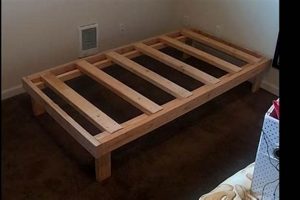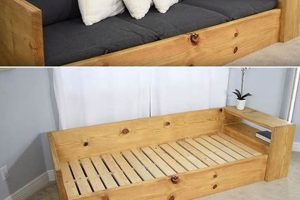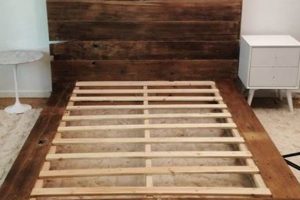A structure elevating a sleeping platform above the floor, often constructed from wood or metal by the user rather than purchased pre-assembled, defines this type of elevated bed setup. These structures can incorporate features like desks, storage, or seating areas beneath the sleeping surface to maximize space utilization. Examples range from simple, minimalist platforms to elaborate, multi-functional constructions.
The appeal of building one’s own elevated bed platform lies in its customization potential and cost-effectiveness. Individuals can tailor the dimensions, design, and materials to precisely fit their spatial needs and aesthetic preferences. Furthermore, constructing a sleeping platform independently can often result in significant savings compared to purchasing a comparable pre-fabricated model, empowering the user with control over both the financial investment and the final products design. Historically, such self-built solutions have been popular in space-constrained environments, such as dormitories and small apartments, where maximizing vertical space is crucial.
Subsequent sections will explore design considerations, material selection, construction techniques, and safety protocols essential for the successful creation of a secure and functional elevated sleeping area. Detailed instructions and common challenges will also be addressed to provide a comprehensive guide for those undertaking this project.
Essential Considerations for Elevated Bed Construction
The following guidance focuses on ensuring both structural integrity and practical functionality when undertaking the construction of an elevated sleeping platform.
Tip 1: Material Selection: Prioritize high-quality lumber or steel. Softwoods require thorough sealing and reinforcement. Steel options demand expertise in welding and metal fabrication to ensure structural soundness.
Tip 2: Structural Calculations: Accurately calculate load-bearing requirements. Account for the weight of the mattress, bedding, and occupants, incorporating a safety margin to prevent collapse.
Tip 3: Secure Fasteners: Employ heavy-duty bolts, screws, and brackets. Ensure they are appropriately sized and spaced to distribute weight evenly and prevent joint failure.
Tip 4: Ladder or Stair Design: Integrate a safe and accessible entry/exit system. Steps should be appropriately sized with a non-slip surface. Inclined ladders require secure mounting and handrails.
Tip 5: Headroom Assessment: Verify adequate vertical clearance above the sleeping platform. Insufficient headroom can lead to discomfort and potential injury.
Tip 6: Guardrail Implementation: Install secure guardrails around the perimeter of the sleeping surface. Rails should meet minimum height requirements to prevent falls.
Tip 7: Floor Protection: Use protective pads or shims beneath the legs or frame. This will prevent damage to the floor and ensure stability, especially on uneven surfaces.
Tip 8: Regular Inspections: Conduct routine checks of all connections and structural components. Address any signs of wear, loosening, or damage immediately.
Adherence to these recommendations will promote both the safety and longevity of the completed project, resulting in a functional and structurally sound elevated sleeping platform.
Subsequent discussion will address frequently encountered challenges and advanced techniques for optimizing the functionality and aesthetic appeal of these customized structures.
1. Structural Integrity
Structural integrity is the foundational element of any elevated sleeping platform. In the context of a user-constructed bed, ensuring robustness is not merely desirable but essential for the safety of the occupant. Compromised structural integrity can lead to catastrophic failure, resulting in injury. The connection here is direct: the quality of materials, precision of construction, and adherence to sound engineering principles directly determine the structural integrity of the finished product. For example, if undersized lumber is used for the support beams, the platform may deflect excessively under load, eventually leading to collapse. Similarly, inadequate fastening techniques, such as using screws that are too short or improperly spaced, can weaken joints and compromise the overall stability. The consequence of neglecting structural considerations is, potentially, structural failure.
Practical application of structural principles involves several key steps. First, accurate load calculations are necessary to determine the required strength of each component. These calculations must account for the static weight of the mattress, bedding, and frame itself, as well as the dynamic weight of the occupant and any potential additional loads. Second, appropriate materials must be selected based on their strength and stiffness characteristics. For wooden frames, hardwoods such as maple or oak are preferable to softwoods like pine, especially for load-bearing members. Steel offers superior strength but requires specialized welding skills. Third, all connections must be meticulously executed using appropriate fasteners and joinery techniques. For example, mortise and tenon joints, reinforced with bolts or screws, provide a strong and durable connection between horizontal and vertical members. Finally, a thorough inspection of the completed frame is necessary to identify any potential weaknesses or defects.
In summary, the structural integrity of a user-built elevated sleeping platform is paramount and intrinsically linked to the quality of materials, design, and construction techniques. Ignoring these factors introduces significant risk. While aesthetics and space-saving benefits are attractive, they must never supersede the fundamental requirement of a safe and stable structure. Ongoing monitoring and maintenance are crucial to ensuring continued structural integrity over the lifespan of the bed. The challenge lies in balancing the desire for a cost-effective and customized solution with the necessity of robust structural engineering principles.
2. Material Selection
The selection of materials is a foundational determinant in the success of a self-constructed elevated sleeping platform. The chosen material directly influences the structural integrity, longevity, and overall safety of the structure. The inherent properties of the material, such as strength, stiffness, and resistance to environmental factors, dictate its suitability for supporting the intended load and withstanding the stresses imposed by daily use. For instance, the choice between softwood lumber, such as pine, and hardwood lumber, such as oak or maple, represents a critical decision point. Softwoods, while more readily available and generally less expensive, possess lower strength and stiffness characteristics, necessitating more robust designs and potentially compromising long-term durability. Conversely, hardwoods offer superior load-bearing capacity but may require specialized tools and techniques for proper fabrication, increasing both the cost and complexity of the project.
Considerations beyond the raw material also extend to fasteners, adhesives, and finishes. The use of appropriate screws, bolts, and brackets is crucial for secure joint construction, ensuring that connections can withstand applied forces without failing. Similarly, the selection of adhesives must align with the chosen material and the intended use, providing a durable and weather-resistant bond where applicable. Finally, the application of appropriate finishes, such as paints, stains, or sealants, protects the material from moisture, UV exposure, and abrasion, extending its lifespan and maintaining its aesthetic appeal. Neglecting these aspects of material selection can lead to premature degradation, structural weakness, and potential safety hazards.
In summary, material selection is not merely a cosmetic consideration in the construction of a personalized elevated sleeping structure; it is a fundamental engineering decision that dictates the structural performance and longevity of the platform. Informed choices, guided by a thorough understanding of material properties and the intended application, are essential for creating a safe, functional, and durable elevated sleeping space. Failure to prioritize material suitability constitutes a significant risk, potentially leading to structural failure and compromising user safety. The challenges of balancing cost considerations with engineering requirements are significant, demanding a reasoned and informed approach to material procurement.
3. Secure Fastening
The efficacy of a self-constructed elevated sleeping platform is fundamentally linked to the security of its fastening mechanisms. These connections bear the entirety of the structure’s load, transferring weight from the sleeping surface to the supporting framework. Inadequate or improperly executed fastening poses a direct threat to the structural integrity of the entire platform, with the potential for catastrophic failure. Examples of compromised fastening include the use of undersized screws, insufficient bolt tightening, or inappropriate bracket selection relative to the materials being joined. The consequence of such failures is joint instability, leading to wobbling, cracking, and eventual collapse. Secure fastening, therefore, is not a mere detail but a critical component of safety and longevity.
Practical application necessitates a thorough understanding of load-bearing principles and the appropriate selection of fasteners for different materials. Wood screws, for example, should be of sufficient length to penetrate deeply into the wood members, ensuring a strong bite. Bolts should be used with washers to distribute pressure evenly and prevent crushing of the wood fibers. Metal brackets must be rated for the anticipated load and securely fastened with appropriate bolts or screws. Furthermore, the spacing of fasteners is a crucial consideration; too few fasteners will weaken the joint, while too many can compromise the wood’s structural integrity. Regular inspection and maintenance are also essential to identify and address any signs of loosening or wear, further securing the longevity and safety of the structure.
In summary, secure fastening is an indispensable element in the construction of a robust and safe user-built elevated sleeping platform. The selection of appropriate fasteners, correct installation techniques, and regular inspection contribute directly to the stability and longevity of the structure. The challenges lie in balancing cost considerations with the necessity of using high-quality fasteners and employing meticulous construction methods. The relationship between fastening security and structural integrity is direct and unequivocal; compromising one invariably compromises the other.
4. Load Capacity
Load capacity is a critical engineering consideration in the design and construction of any elevated sleeping platform. It dictates the maximum weight the structure can safely bear, encompassing the static weight of the frame, mattress, and bedding, as well as the dynamic weight of the occupant(s) and any potential additional loads. Exceeding the designed load capacity can result in structural failure, leading to property damage or personal injury.
- Material Strength and Span
The choice of materials, such as wood or steel, directly impacts the platform’s load-bearing capability. Different materials possess varying degrees of strength and stiffness, influencing the allowable span between support structures. For instance, a longer span with a less robust material will significantly reduce the load it can safely support. The design must consider the material’s properties in relation to the intended span to ensure sufficient load capacity.
- Joint Integrity and Fasteners
The strength of joints, created using fasteners such as screws, bolts, or welding, is paramount to overall load capacity. Weak or improperly constructed joints serve as points of potential failure. The size, type, and spacing of fasteners must be carefully selected to adequately distribute the load across the joint. Failure to properly reinforce joints can compromise the entire structure’s load-bearing capability.
- Distribution of Load
The way the load is distributed across the platform influences its overall stability and load capacity. Concentrated loads, such as the weight of an individual in a specific area, place higher stresses on the supporting members directly beneath. Designs must account for the anticipated distribution of weight, potentially requiring additional support structures or reinforcement in high-stress areas. Uneven weight distribution can significantly reduce the effective load capacity.
- Safety Factors and Design Codes
Engineering practice dictates the incorporation of safety factors when calculating load capacity. These safety factors provide a margin of error to account for unforeseen loads or material imperfections. Adherence to relevant building codes and engineering standards is also crucial to ensure that the platform meets minimum safety requirements. Ignoring safety factors or code requirements can result in an under-engineered structure with insufficient load capacity.
The interplay of material strength, joint integrity, load distribution, and safety factors culminates in the overall load capacity of the elevated sleeping platform. Neglecting any of these elements compromises the structural integrity and safety of the completed project. Accurately assessing and adhering to these principles is paramount when undertaking the construction of an elevated sleeping space.
5. Safety Rails
Safety rails are an indispensable component of elevated sleeping platforms, particularly within the context of user-constructed frames. Their primary function is to prevent falls from the elevated sleeping surface, mitigating the risk of serious injury. The integration of properly designed and constructed safety rails is non-negotiable in ensuring user safety.
- Height and Coverage
The height of safety rails must meet minimum standards to effectively contain an occupant during sleep. Building codes often stipulate minimum heights, typically ranging from 12 to 16 inches above the mattress surface. Full coverage, extending along the entire perimeter of the sleeping area, is crucial, with minimal gaps that could allow for accidental egress. Failure to adhere to height and coverage requirements significantly increases the risk of falls.
- Structural Integrity and Attachment
Safety rails must possess sufficient structural integrity to withstand lateral forces exerted by an occupant leaning or falling against them. Robust construction, utilizing durable materials and secure fastening techniques, is essential. The method of attachment to the platform frame must be equally strong, preventing the rails from detaching under stress. Weak or poorly attached safety rails offer a false sense of security and may exacerbate injuries in the event of a fall.
- Accessibility and Egress
While preventing falls is paramount, safety rail design must also accommodate safe and convenient access to and egress from the sleeping platform. Integrating a secure ladder or stair system, combined with a strategically positioned opening in the safety rail, allows for easy entry and exit. The opening should be designed to minimize the risk of accidental falls while still providing unobstructed access. Balancing fall prevention with accessibility is a key design consideration.
- Material and Finish
The materials used for safety rails should be non-toxic, durable, and free from sharp edges or protrusions that could cause injury. Smooth, rounded edges and a durable finish are essential to prevent splinters, abrasions, or other skin irritations. The choice of material should also complement the overall aesthetic of the elevated sleeping platform. Selecting appropriate materials and finishes enhances both the safety and the aesthetic appeal of the structure.
The implementation of properly designed and constructed safety rails is a fundamental responsibility in the construction of a personalized elevated sleeping space. Safety rails directly mitigate the potential for falls, injuries, and subsequent liability. Adherence to established safety standards, coupled with meticulous construction practices, is essential for creating a secure and functional sleeping environment.
6. Access Design
Access design, in the context of a user-constructed elevated sleeping platform, pertains to the method by which individuals safely and efficiently ascend to and descend from the sleeping surface. It is not merely a convenience; rather, it represents a critical safety component. Poor access design can directly contribute to falls, injuries, and user frustration, thereby negating the space-saving and customization benefits typically sought in such projects. For instance, a poorly angled ladder with narrow rungs can be difficult and hazardous to navigate, especially in low-light conditions or for individuals with mobility limitations. This could lead to missteps, falls, and associated injuries.
Considerations for effective access design encompass several key elements. First, the selection of an appropriate access method be it a ladder, stairs, or a ramp is crucial. Ladders are often chosen for their space-saving attributes, but stairs offer enhanced stability and ease of use, particularly for frequent access or for users with physical limitations. Second, the angle of ascent is a significant factor; steeper angles increase the risk of falls, while shallower angles require more floor space. Third, the dimensions of steps or rungs, including width, depth, and spacing, must be carefully considered to ensure a comfortable and secure foothold. Furthermore, the inclusion of handrails or grab bars can significantly enhance stability and reduce the risk of falls, especially for ladders. Real-world examples of thoughtfully designed access include stairs with integrated storage compartments or ladders that can be easily stowed away when not in use, optimizing both safety and space utilization.
In summary, access design is an integral element in the successful creation of a user-built elevated sleeping area, directly impacting user safety and overall satisfaction. Careful consideration of access method, angle, dimensions, and safety features is essential to mitigate the risk of falls and injuries. While challenges may arise in balancing space constraints with safety requirements, prioritizing thoughtful access design is crucial for creating a functional and secure elevated sleeping environment. The potential consequences of neglecting this aspect are severe, underscoring the importance of prioritizing safe and accessible ascent and descent solutions.
7. Space Optimization
Space optimization, in the context of user-constructed elevated sleeping platforms, denotes the strategies employed to maximize the efficient utilization of available spatial volume, particularly in environments characterized by limited square footage. The inherent design of an elevated sleeping area lends itself to creative space management, transforming previously underutilized vertical space into functional living or storage areas. Effective space optimization is a primary motivator for undertaking a do-it-yourself elevated bed project.
- Vertical Space Utilization
An elevated sleeping platform inherently capitalizes on vertical space. By raising the sleeping area, the footprint occupied by a conventional bed is effectively doubled, creating usable space beneath. This space can then be repurposed for various functions, such as a dedicated workspace, a reading nook, or a storage area. The impact of this vertical expansion is particularly significant in small apartments or dormitories where floor space is at a premium. For example, a standard twin-sized bed occupies approximately 20 square feet of floor space; an elevated platform allows for the reclamation of this area, enabling the addition of a desk, shelves, or even a small seating area.
- Integrated Storage Solutions
The area beneath an elevated sleeping platform can be effectively utilized for integrated storage solutions. Drawers, shelves, and cubbies can be seamlessly incorporated into the structure’s design, providing ample storage for clothing, books, and other personal belongings. This integrated approach eliminates the need for separate storage units, further optimizing available space. An example includes incorporating rolling storage containers beneath the platform for easy access to stored items. The design and dimensions of these storage solutions can be customized to meet specific needs and preferences, maximizing the efficiency of the space.
- Multi-Functional Design Elements
The design of a personalized elevated sleeping platform allows for the integration of multi-functional elements. A common example is the incorporation of a desk directly beneath the sleeping area, creating a dedicated workspace. Other possibilities include integrating a seating area, a bookcase, or even a small entertainment center. This multi-functional approach allows for the creation of a compact and efficient living space, catering to diverse needs within a limited area. Consider a platform design that incorporates a fold-down desk, allowing for a flexible workspace that can be concealed when not in use.
- Customization and Adaptability
The inherent benefit of a user-constructed elevated sleeping platform lies in its ability to be fully customized to meet specific spatial constraints and functional requirements. The dimensions, configuration, and features of the platform can be tailored to perfectly fit the available space and accommodate individual needs. This adaptability is particularly valuable in irregular or awkwardly shaped rooms where standard furniture solutions may not be suitable. Examples of this customization include designing a platform to fit beneath a sloped ceiling or incorporating a unique access solution to accommodate limited floor space.
The optimization of space through the construction of an elevated sleeping structure is a multifaceted endeavor. The vertical expansion, integrated storage, multi-functional elements, and customization options collectively contribute to the efficient utilization of available space. These strategies, when thoughtfully implemented, transform a standard sleeping area into a highly functional and versatile living environment, showcasing the benefits of a user-constructed elevated platform.
Frequently Asked Questions
The following addresses common inquiries and clarifies critical aspects related to the design and construction of a user-built elevated sleeping platform.
Question 1: What are the primary safety concerns associated with self-constructed elevated sleeping platforms?
Key safety considerations include structural integrity, load capacity, stability, and fall prevention. Ensuring the frame can withstand the intended load, securing all connections, and implementing adequate safety rails are paramount. Insufficient attention to these areas can result in structural failure and potential injury.
Question 2: What materials are suitable for constructing a durable and safe elevated bed platform?
Hardwoods, such as oak or maple, and steel are commonly used due to their high strength and durability. Softwoods, like pine, require careful sealing and reinforcement. Metal demands expertise in welding and metal fabrication. The chosen material must be able to bear the intended load and withstand the stresses of daily use.
Question 3: What is the minimum recommended height for safety rails on a self-built elevated sleeping platform?
Safety rails should extend at least 12 inches above the top of the mattress to prevent falls. The rails should be continuous along all open sides of the sleeping area, with minimal gaps that could allow for accidental egress.
Question 4: How is load capacity calculated for a user-constructed elevated sleeping area?
Load capacity calculations must account for the static weight of the frame, mattress, and bedding, as well as the dynamic weight of the occupant(s). Engineering principles dictate the inclusion of safety factors to accommodate unforeseen loads or material imperfections. Failure to accurately calculate load capacity can lead to structural failure.
Question 5: What are the essential elements of a safe and functional access design?
Access design should prioritize safety and ease of use. Ladders should be angled for comfortable climbing, with rungs spaced appropriately. Stairs offer enhanced stability and are preferable for frequent use or users with mobility limitations. Handrails are highly recommended to provide additional support and prevent falls.
Question 6: How can available space be optimized when constructing a personalized elevated sleeping area?
Elevated platforms inherently create usable space beneath the sleeping area. This space can be utilized for a desk, storage units, seating, or other functional purposes. Integrated storage solutions, such as drawers or shelves built into the frame, are particularly effective in maximizing space utilization.
In summary, user-built elevated sleeping platforms present an opportunity to customize living spaces, but require meticulous attention to safety, structural integrity, and functional design. Comprehensive planning and adherence to sound construction principles are essential for a successful outcome.
The subsequent section will explore advanced design considerations and creative applications for enhancing the functionality and aesthetic appeal of personalized elevated sleeping structures.
Conclusion
The preceding exploration of the diy loft bed frame has elucidated essential design and construction principles. Critical elements encompassing structural integrity, material selection, secure fastening, load capacity, safety rail implementation, access design, and space optimization have been examined. Emphasis has been placed on the interdependency of these factors and their combined influence on the overall safety and functionality of a personalized elevated sleeping structure.
The information provided serves as a foundation for informed decision-making and responsible execution. Individuals embarking on a diy loft bed frame project must prioritize safety, adhere to sound engineering practices, and remain cognizant of the potential risks associated with self-constructed elevated structures. Ongoing diligence in maintenance and inspection is equally vital to ensuring continued structural integrity and user safety over time.







